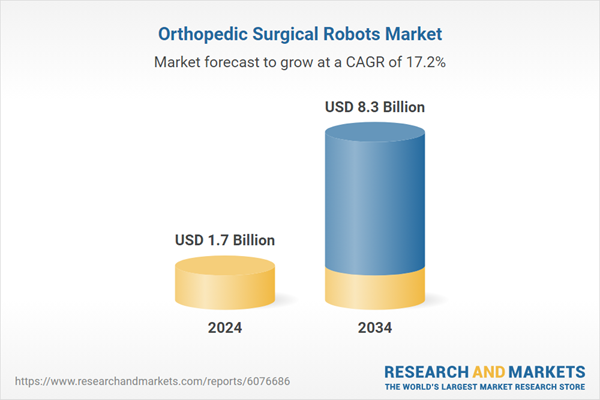In addition, surgeons are embracing robotic systems due to their enhanced visualization capabilities, real-time data integration, and improved dexterity during complex procedures. With robotics transforming the way orthopedic surgeries are performed, more hospitals and surgical centers are investing in these systems to optimize patient care. The push for value-based care and favorable insurance coverage in several countries is also supporting this trend. As robotics evolve with AI and machine learning, these systems are expected to play an even bigger role in orthopedic healthcare over the coming decade.
The component segment includes robotic systems, accessories, software, and services. The robotic systems segment generated USD 890.3 million in 2024. These systems are gaining traction because they offer surgeons greater control and precision in performing delicate orthopedic surgeries, particularly in spinal and joint procedures. Their ability to improve implant alignment, reduce the risk of complications, and shorten recovery time makes them a preferred choice across hospitals and specialty clinics. With features like 3D visualization, haptic feedback, and advanced imaging support, robotic platforms are transforming the surgical workflow and enhancing overall outcomes.
By end use, the hospitals segment held a 52.9% share in 2024. Hospitals continue to dominate the market due to their strong clinical infrastructure, a high influx of orthopedic cases, and a growing emphasis on technological upgrades. They rely heavily on robotic systems to improve procedural consistency, reduce human error, and manage complex cases with greater efficiency. The rising number of geriatric patients and favorable reimbursement policies are also making it easier for hospitals to adopt and scale robotic-assisted surgical solutions.
North America Orthopedic Surgical Robots Market held a 41.9% share in 2024. The region's dominance is driven by its robust healthcare infrastructure, rising adoption of AI-powered technologies, and an increasing need for precision-based, minimally invasive orthopedic procedures. As joint-related conditions like osteoarthritis and osteoporosis continue to rise, North American hospitals and surgical centers are leading the charge in integrating next-gen robotic systems into their practices.
Prominent companies in the Global Orthopedic Surgical Robots Market include Medtronic, Think Surgical, Globus Medical, Brainlab, Accuray, MicroPort Orthopedics, Intuitive, Johnson & Johnson, CUREXO, Smith & Nephew, Asensus Surgical, Zimmer Biomet, Corin, Stryker, and NUVASIVE. These players are actively investing in R&D to refine surgical accuracy, integrate AI and haptics, and develop tailored solutions for diverse clinical needs. Many are expanding their global presence through partnerships with hospitals and distributors, while offering robust post-sales support and training to enhance user adoption and performance.
Comprehensive Market Analysis and Forecast
- Industry trends, key growth drivers, challenges, future opportunities, and regulatory landscape
- Competitive landscape with Porter’s Five Forces and PESTEL analysis
- Market size, segmentation, and regional forecasts
- In-depth company profiles, business strategies, financial insights, and SWOT analysis
This product will be delivered within 2-4 business days.
Table of Contents
Companies Mentioned
The companies featured in this orthopedic surgical robots market report include:- Accuray
- Asensus Surgical
- Brainlab
- Corin
- CUREXO
- Globus Medical
- Intuitive
- Johnson & Joshnson
- Medtronic
- MicroPort Orthopedics
- NUVASIVE
- Smith & Nephew
- Stryker
- Think Surgical
- Zimmer Biomet
Table Information
| Report Attribute | Details |
|---|---|
| No. of Pages | 131 |
| Published | April 2025 |
| Forecast Period | 2024 - 2034 |
| Estimated Market Value ( USD | $ 1.7 Billion |
| Forecasted Market Value ( USD | $ 8.3 Billion |
| Compound Annual Growth Rate | 17.2% |
| Regions Covered | Global |
| No. of Companies Mentioned | 16 |









